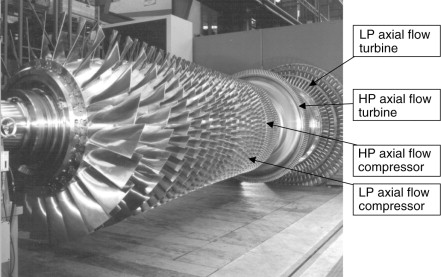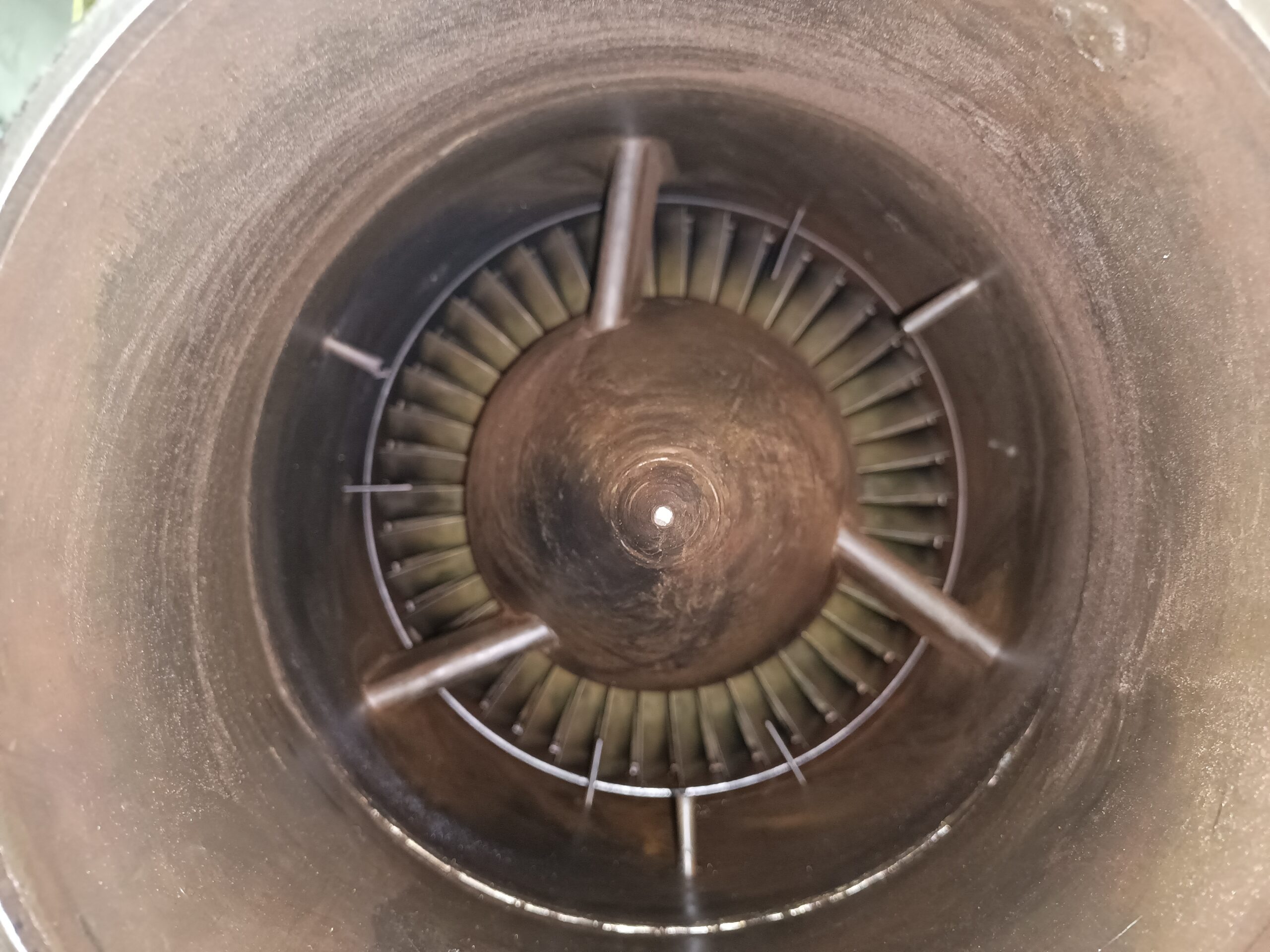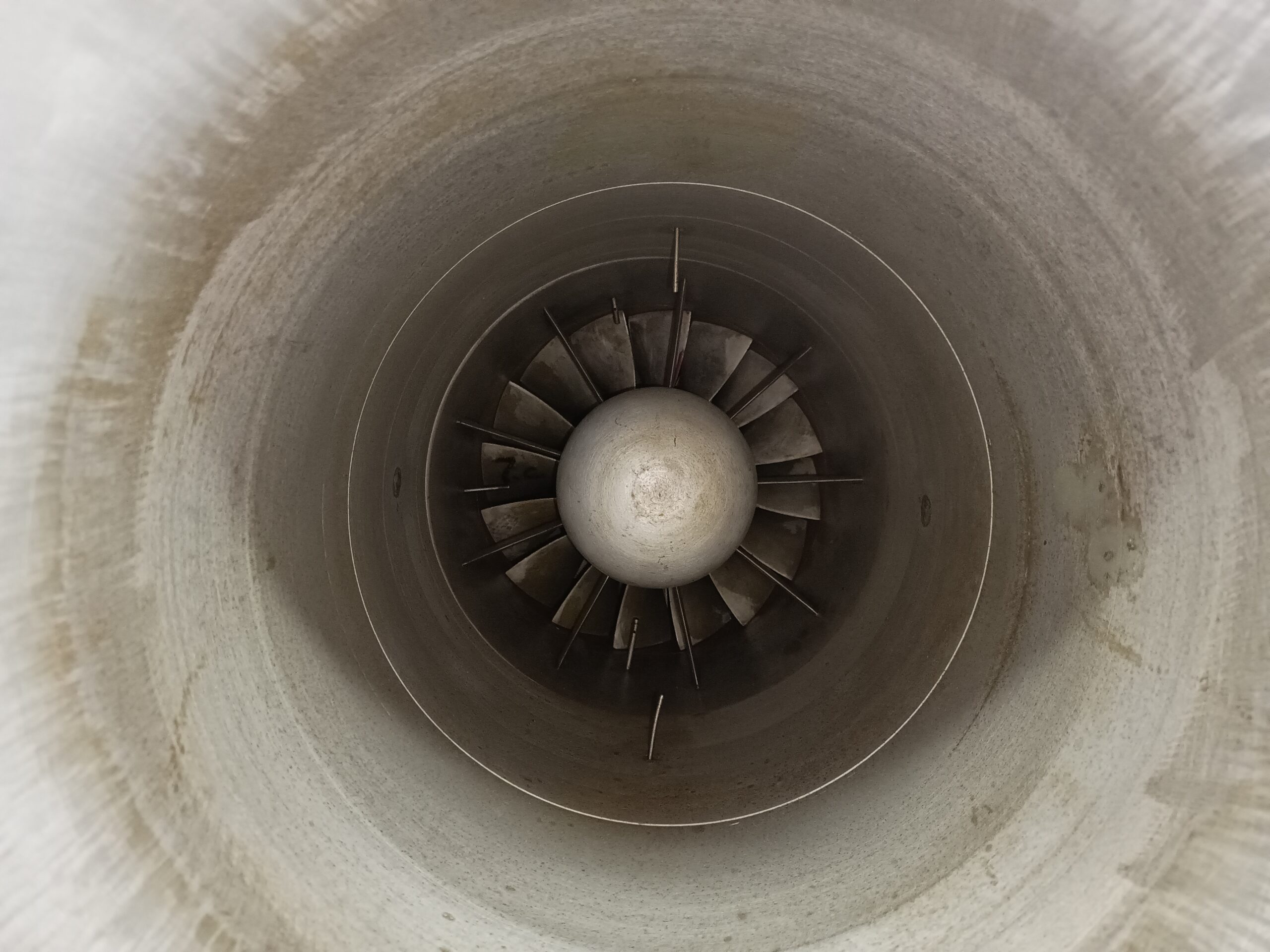Design of turbomachines
General scheme of axial compressor and turbine
Table of contents
Design of turbomachines
1.Principles of turbine design
Turbines are devices that extract energy from a fluid flow (gas, steam, or water) and convert it into mechanical energy. Designing turbines requires a precise understanding of fluid dynamics, mechanics, and thermodynamics.
a) Fluid dynamics and aerodynamics
Turbine systems are usually designed as a set of blades and disks that rotate on a rotor. The fluid (gas, steam, or water) enters through the stators and, after passing through these components, its energy is converted into mechanical energy.
Blade theory: The design of blades is specifically carried out to optimize fluid flow and reduce losses. Blades must be designed so that the flow remains laminar to prevent turbulence and efficiency loss. Additionally, the blade angle of attack must be optimized to avoid turbine stall.
CFD (Computational Fluid Dynamics): CFD software is used to simulate the fluid flow behavior around blades and stators. These simulations help engineers to analyze and optimize different blade designs and turbine structures.
b) Thermodynamics
Thermal cycle of turbines: Turbines are commonly used in power plant systems that operate based on thermodynamic cycles such as the Rankine Cycle for steam turbines and the Brayton Cycle for gas turbines. Turbine design in this context aims to extract the maximum energy from steam or hot gas.
Energy conversion: In turbines, the fluid (such as steam or gas) passes through the blades and converts its thermal energy into mechanical energy. This process must be designed to minimize losses in energy conversion.
c) Materials and durability
Turbines operate at very high temperatures (for example, in jet engines or steam power plants). Therefore, the materials used must have specific properties such as fatigue resistance, high-temperature resistance, and tensile strength. Titanium alloys, nickel, and superalloys are often used in the manufacturing of blades and rotors.
2.Principles of compressor design
Compressors are devices that compress gas and increase its pressure. Designing compressors requires attention to complex principles of fluid mechanics, dynamics, and heat control.
a) Fluid dynamics and aerodynamics
Axial compressors: In these compressors, the gas is gradually compressed as it passes through the rotor blades. The design of these blades ensures that the gas flow continues axially and prevents pressure loss along the path.
Centrifugal compressors: In these compressors, the gas is thrown outward at high speed by the rotor blades, increasing its pressure. In these systems, kinetic energy is converted into pressure energy.
In compressors, the blade angle, gas velocity, and rotor structure must be designed to prevent turbulence and ensure smooth, uninterrupted fluid flow.
b) Compression Process
Compressors typically utilize multiple compression stages to gradually increase gas pressure. Each stage is designed to minimize energy losses and achieve the desired output pressure efficiently.
In piston compressors, gas is compressed by pistons, while in rotary compressors, this process is carried out using rotary mechanisms.
c) Temperature control and refrigeration
Gas compression leads to an increase in temperature, so cooling or refrigeration systems are needed to prevent the gas from overheating and damaging the compressor. Refrigeration systems are usually designed to have the capability to cool the compressed gas quickly and efficiently.
3.Analysis and design with the help of software
The use of engineering software such as CFD (Computational Fluid Dynamics) and FEM (Finite Element Method) is essential for analyzing the fluid behavior and mechanical structure of turbines and compressors.
CFD: These software tools enable engineers to simulate and optimize the fluid flow behavior along the path from the inlet to the outlet of the turbine or compressor.
FEM: These software tools are used to analyze stresses, strains, and mechanical behavior of turbine and compressor components. Especially in turbine blades and compressor rotors, which are subjected to high pressures and temperatures, the use of FEM can help analyze and improve the durability of the parts.
4.Design challenges of turbines and compressors
Vibration and acoustics: Rotating devices such as turbines and compressors often experience severe vibrations. These vibrations can lead to premature component failure or reduced efficiency. Therefore, designing balancing and vibration-damping systems is crucial.
Material fatigue: In the design of turbines and compressors, material fatigue is one of the biggest challenges. The components must be designed to withstand dynamic loads and long-term oscillations.
5.Optimization methods and new innovations in turbomachinery design
Design using advanced materials: Advanced materials such as high-temperature-resistant superalloys and composites can improve the performance of turbines and compressors. These materials are especially used in parts subjected to high pressure and temperatures, such as turbine blades or compressor rotors.
Use of 3D printing: 3D printing technology is employed to manufacture complex and high-precision components, which can help reduce costs and production time.
6. Standards and regulations
The design of turbines and compressors must comply with international standards to ensure their safety, efficiency, and reliability. Some of these standards include:
ASME (American Society of Mechanical Engineers) for the design of turbines and compressors.
ISO 9001 for quality management in manufacturing and design processes.
API (American Petroleum Institute) for the design of industrial compressors.
Initial steps in the turbomachinery design process
Design and analysis of steam turbines is a specialized and rapidly advancing field in energy engineering, in which our center focuses on expanding knowledge and developing expertise. Steam turbines are among the complex technologies that play a vital role in energy production systems. Our center, with an approach based on continuous learning and gradual improvement, strives to achieve more optimal analysis of these systems by utilizing advanced numerical methods and precise simulations.
Currently, our design process involves using mainline analysis as a primary tool to predict the overall performance of the turbine. This method provides a suitable framework for evaluating power output, overall efficiency, and understanding the general fluid behavior within the turbine. Following this stage, dynamic and transient simulations are conducted for each turbine stage, including velocity triangle analysis, calculation of energy losses, and examination of temperature and pressure variations in the fluid flow. In this process, we utilize advanced computational tools such as MATLAB and HYSYS, which enable more precise thermodynamic and fluid dynamic analyses.
One of the developing areas in our center is the analysis and simulation of radial turbines (ROT). Due to their unique structure, these turbines exhibit more complex flow behavior compared to axial turbines, and accurate analysis requires a deeper understanding of dynamic and thermodynamic concepts. Despite limited access to comprehensive experimental data for this type of turbine, we rely on validated simulation sources and research data to advance our studies. Additionally, we strive to improve the accuracy and credibility of our analyses by using benchmark data and comparing simulation results with published scientific papers.
We are on a path of continuous growth and learning, striving to meet the diverse needs of industrial projects by enhancing the knowledge of our engineering team. While we have already implemented many advanced tools and methods in our processes, we continue to seek out innovative approaches and improve existing techniques. Our goal along this journey is to increase the accuracy of our analyses, deepen our understanding of turbine behavior under various operating conditions, and move toward more optimized and reliable designs for future projects.
External resources for turbomachinery design
Table of contents
Sample images of turbomachinery designs





What is the main function of turbines in mechanical systems?
✅ Conversion of fluid energy (steam, gas, or water) into mechanical energy.
Why is the blade angle of attack important in turbine design?
✅ Because an improper angle can cause turbine failure and aerodynamic performance loss.
What are the main components of a turbocharging test rig?
✅ Turbine, compressor, internal combustion engine (gasoline or gas-powered), lubrication system, cooling system, precise sensors, and data acquisition and control unit.
What are the key parameters examined in a turbocharging test?
✅ Pressure ratio, thermal and mechanical efficiency, turbocharger rotational speed, gas mass flow rate, and temperature ratio.
Why is the use of resistant materials important in manufacturing turbocharging laboratory components?
✅ Due to high temperature and pressure in the process, heat- and corrosion-resistant materials must be used to prevent component damage and increase equipment lifespan.
What are the advantages of using a turbocharging test rig?
✅ Increased engine efficiency, reduced fuel consumption, lower emissions, and the ability to test critical conditions to ensure stable system performance.
What capabilities does this laboratory have?
✅ Studying turbocharger matching with different engines, performing theoretical and experimental modeling and simulation, examining emissions, and improving the performance of gasoline, diesel, and gas-powered engines.
What projects have been carried out in this field?
✅ Theoretical and experimental investigation of supercharging, reducing NOx emissions in turbocharged gas engines, and increasing gasoline engine power through intake air temperature control.
Why is real-time data monitoring important in the test circuit?
✅ To accurately record temperature, pressure, and velocity changes during the test and to analyze system performance precisely under different conditions.
Why is precise control of test conditions essential?
✅ To ensure the obtained data are accurate, reliable, and repeatable, and that the system design is properly optimized.




